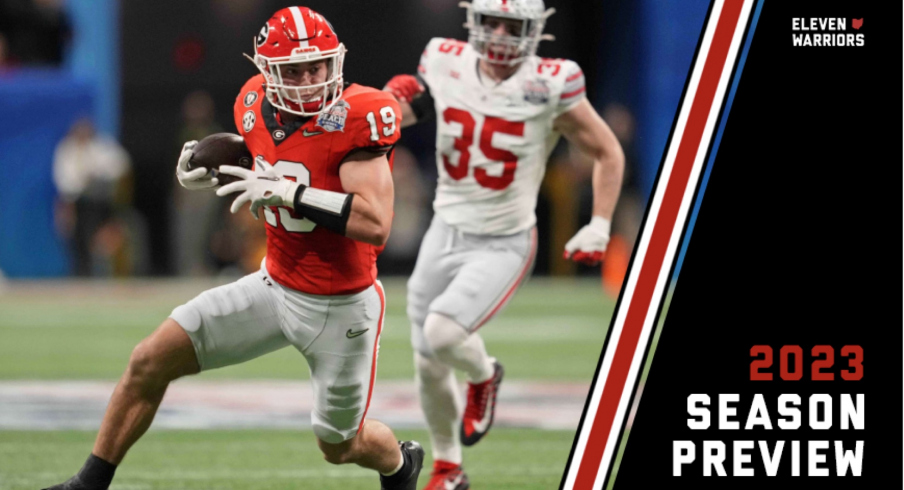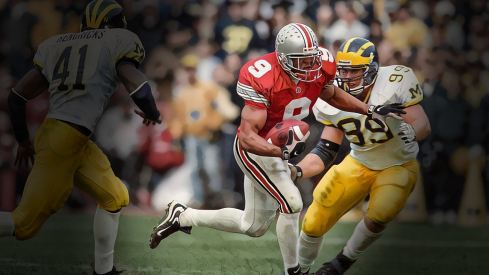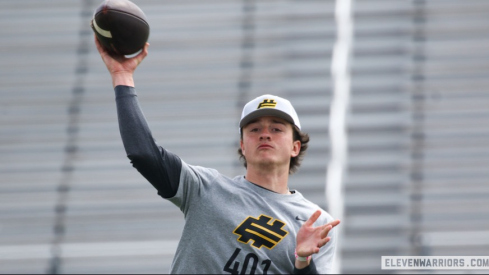"That's what complete offenses do to you. They try to put you in conflict. That's the whole idea of an offense that's complete and total and has different tools and targets and ways to keep you off balance." - Jim Knowles
While uptempo, no-huddle systems and shotgun option plays may have been key components in the spread offense (r)evolution over the past two decades, the elemental change in how the game is played today is the ability to cover space.
When Randy Walker's Northwestern squad upset the visitors from Ann Arbor 23 years ago, marking the beginning of this movement in the Big Ten, the Wildcats proved that a 230 lb linebacker was not the answer to stopping a slot receiver on a bubble screen, no matter their recruiting profile.
This philosophy of spreading out defenses wider and wider, forcing each individual defender to cover more and more space, permeated all levels of the sport, and is now common everywhere from the NFL to junior high. Even the professional game, which resisted these changes for most of the 2000s, now recognizes that a normal offense includes three wide receivers and only one running back.
But given their massive coaching staffs and absence of recruiting responsibilities, as well as the sheer volume of high-quality video available to them thanks to modern technology, NFL defenses are rarely caught unprepared when defending the 100 by 53.5 yards necessary each week. If you're not sure what I mean, just think about the 'Wildcat' craze and how quickly that was rendered moot.
NFL offenses can't just show up each week and run Four Verticals over and over, even with the league's fastest group of wide receivers and a cannon-armed QB. Otherwise, the Raiders would have won a half-dozen Super Bowls by now.
Instead, the professionals must rely on disguise, using pre-snap alignments to create post-snap mismatches in favor of the offense. And no position is more capable of creating such mismatches than the modern tight end.
No longer a sixth lineman, these freaks of nature might line up in a three-point stance one play, in the backfield next to the QB the next, and split out wide the play after that, all the while motioning from one spot to the other and/or from side to side. Trying to plan a defensive scheme around the location of such an individual can be maddening for opposing coaches...and is why an increasing number of offenses have begun employing two at once.
Why else would Ryan Day choose to take off one of the many five-star wide receivers at his disposal in favor of a 246 lb former walk-on like Mitch Rossi no less than 30% of the time last season? Yet the Buckeyes led the nation in yards-per-play (7.3) last season due in large part to their use of 12 Personnel (1 RB, 2 TE) on nearly a third of their offensive snaps.
But Ohio State was far from leading the pack in this regard, as a number of opponents last season frequently trotted out 12 personnel against Day's defense. Much was written here and elsewhere about the challenge posed by Georgia's Brock Bowers and Darnell Washington in the CFP semifinal, as the Dawgs played with two tight ends on the field 52% of the time last season.
But Notre Dame, Penn State, and Michigan (each of whom remain on the 2024 schedule), all used 12 personnel for the majority of their games against OSU. Despite the perception that last year's Silver Bullets still struggled to stop physical running games as had been the case a year prior, Jim Knowles' troops had no trouble stopping predictable, downhill run games when facing these heavy personnel packages.
Instead, what gave Ohio State more trouble was when these massive athletes weren't used as blockers, but as skill players. Bowers' athletic talents are well known at this point, but the sheer volume of places in which he lined up throughout the Peach Bowl kept the Buckeyes on their heels.
Bowers, though, was simply following a trend that many offenses have begun to employ against teams full of talented players on the opposite side of the ball. As we can see, the four best opponents on OSU's 2022 schedule not only employed two-tight end sets a majority of the time in these matchups, but they found success in lining them all over the field.
| Name | Team | Team Yds/Play | In-Line (Traditional TE) | Slot | Split Wide | Backfield |
|---|---|---|---|---|---|---|
| Michael Mayer | Notre Dame | 5.27 | 22 | 15 | 6 | 3 |
| Kevin Bauman | Notre Dame | 5.27 | 20 | 5 | 2 | 1 |
| Theo Johnson | Penn State | 6.03 | 23 | 28 | 3 | 6 |
| Brenton Strange | Penn State | 6.03 | 18 | 25 | 15 | |
| Luke Schoonmaker | Michigan | 8.83 | 22 | 1 | 1 | |
| Colston Loveland | Michigan | 8.83 | 36 | 10 | 2 | 2 |
| Brock Bowers | Georgia | 8.88 | 20 | 30 | 9 | 2 |
| Darnell Washington | Georgia | 8.88 | 5 | 6 | 1 | |
| Oscar Delp | Georgia | 8.88 | 18 | 5 |
"The fact that they can line up tight to the formation and wide, you have to prepare for those two tight end sets," Knowles said in advance of the Peach Bowl matchup with Georgia. "And you know you're not going to get that all the time. But if you're not prepared for that, they can do damage from the line of scrimmage. And then you make the adjustments when they move out, but they're certainly dangerous wherever they line up.
Perhaps no better example came when Bowers was used as a decoy on...a Jet Sweep. After initially lining up with a tight end in a wing position to either side of the formation, Bowers' motion pulled the entire OSU defense in his direction and away from a handoff, allowing the Bulldogs to have a 4-on-4 blocking advantage to the back side and opening up a huge crease for Kenny McIntosh to run through untouched.
blah
While some might be wondering why the defense bit on a fake handoff to a tight end, of all people, it's worth noting that Bowers had 13 career carries for 165 yards and four touchdowns coming into the game. Averaging 12.7 yards per carry is worth noticing, regardless of any listed position in the program.
Such pre-snap movement meant to relocate defenders has become a common part of the game, and one which proved successful during Knowles' first season in Columbus. Penn State, another opponent who proved capable of moving the ball against Knowles' defense, used their tight ends more against Ohio State than any other opponent last season, and did so quite creatively.
Former OSU assistant Mike Yurcich consistently showed one look with 12 Personnel, then shifted his offense into something completely different before snapping the ball. As the defense over-compensated to the pre-snap movement, giant pockets of space were created, allowing quarterback Sean Clifford to deliver easy completions.
blah
Similarly, the versatility of these modern tight ends allowed Yurcich to incorporate hurry-up elements into his game plan. The Nittany Lions might line up in an I-formation on one play, then show a four-wide formation just seconds later on the next snap, all without changing personnel.
Their opponents, meanwhile, were forced to defend both looks while also not being able to substitute. This forced similar hybrid defenders opposite the tight ends, like the OSU safeties, to account for these different alignments on the fly, and the results weren't always pretty.
In the example below, PSU had just converted a first down and quickly hurried to the line without huddling. Given the personnel and situation, Knowles seemed to expect a run and called for a five-man pressure that blitzed Ronnie Hickman from the middle (Adjuster) safety spot in order to have more bodies at the expected point of attack. Behind that front, though, was a depleted secondary playing a three-deep, three-under zone coverage.
Yurcich, of course, lined up his wideouts nearly on the sidelines with both tight ends in the slot, stretching the defense horizontally before the ball had been snapped, just like many Spread offensive coaches have done for years. But because the defense expected a run from this personnel group in this situation, they were left undermanned when the offense ended up throwing downfield, creating a vertical stretch as well.
While Lathan Ransom appears to mis-play the post route to the weak side from his middle zone, he is simultaneously being ask to help defend two post patterns 30 yards apart, as the tight ends dragged the alley defenders completely out of the play on matching wheel routes. In short, it wasn't the concept itself that beat Knowles and his defense, it was how that concept was set up to make Ohio State think something completely different was coming their way, and thus, be out of position to stop what was coming their way.
There are a couple of reasons why OSU has seemed so vulnerable to this kind of deception in recent years, despite changes at defensive coordinator.
First, the Buckeyes are circled on every opponent's calendar as the biggest game of the year, and opposing coaches often hold back special concepts (such as a jump pass from the fullback) for just this occasion. Not only will new concepts be seen, tendencies will be broken solely to keep Knowles on his heels.
But second, the Buckeyes' reliance on man-coverage was once again used against them. While man-coverage is the easiest way to defend unique formations and pre-snap movement, as every defender is simply assigned an offensive player and mirrors him, it's also the easiest coverage to manipulate, allowing opposing play-callers like Yurcich or Georgia's Todd Monken to move defenders out of a play via the use of decoys (such as Bowers' Jet fake above).
According to PFF tracking, the Buckeyes played man-coverage 28% of the time last season, the most of any coverage in their arsenal (though that number was down significantly from previous years).
Jim Knowles & the search for the ultimate hybrid defense.
— Cody Alexander (@The_Coach_A) July 3, 2023
> Part 1 (Oklahoma St. '21): https://t.co/rlHUeobc5p
> Part 2 (Ohio St. '22): https://t.co/xOmaUtHOsZ#ArtofX pic.twitter.com/2K4AEVuTl9
Partly, this reliance on man (Cover 1) was likely due to what the players had known, and 2022 was more of a transition year as they got more used to their new coordinator's style. But given the state of the game today, there is no one coverage that is superior to others, as knowledge of the game is now so widespread that play-callers on both sides of the ball know how to defeat any look or scheme shown by their opponent.
So instead of leaning on one or two staple coverages to lean on, such as Chris Ash did with his Quarters scheme in 2014, Knowles has recognized the modern trend and tries to counter the offense's use of hybrid players by disguising his looks as well.
Many people interpreted his comments of 'playing offense on defense' after being hired to simply mean more aggressive play-calling (i.e. more blitzes), but the reality was he did more than nearly any other team in the country to disguise his scheme from play to play. The Buckeyes showed one look pre-snap before dropping into something entirely different after the ball was in play 30.8% of the time last season, the highest-such mark in the Big Ten, and the seventh-highest among all Power-5 teams.
While some fans and analysts were disappointed to see the Buckeyes still employing so much 3-deep coverage last fall, the way in which it was deployed was a far cry from years prior. As many readers will know, Knowles will line up his three-safety defense in a variety of ways, which allows him to mix and match who covers which zone, creating confusion for the opposing quarterback.
Such disguises in Cover 3 have become common thanks to the Rip/Liz system made famous by Nick Saban, as countless coaches across all levels of the sport now know how to show a two-high look before dropping one safety into the box after the snap.
What makes Knowles disguises unique is his willingness to do the opposite, showing a closed look pre-snap (with a safety in the middle of the field), and then play an open, two-deep coverage such as Cover 2 or Quarters. Most coaches avoid this, as it asks a defender playing deep line up in the box before dropping quickly at the snap, but only Iowa State and Kansas State did this more often than Ohio State in 2022 (10.3% of snaps).
As we can see, there are safeties playing all over the field in these deceptive schemes, echoing the responsibilities of modern tight ends. And just like their offensive counterparts, the more safeties that are on the field at once, the more flexibility the entire unit can have to execute different schemes.
With this eye toward disguise and a host players with different skill sets looking likely to see time at the safety positions, Knowles seems more prepared to take on the constantly evolving threat of modern offenses in year two.



